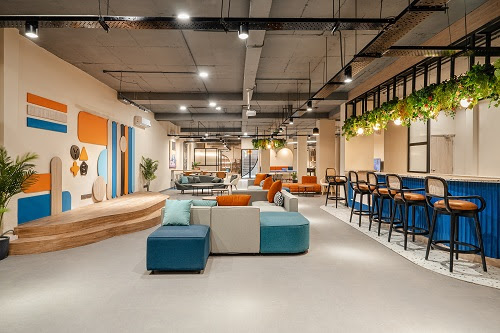E - PAPER
MARVELS OF REAL ESTATE
AFTER A YEAR OF GLOBAL PANDEMIC, THE REAL ESTATE IF ANYTHING, HAS EMERGED STRONGER AND MORE RESILIENT. NOT WITHSTANDING THE CHALLENGES, THE SECTOR CONTINUES TO WORK HARDER AND CREATE SPACES TO LIVE WORK AND PLAY. REALTY+ HIGHLIGHTS SOME OF THE PRESTIGIOUS PROJECTS UNDERWAY, FROM ACROSS THE C
 BY
Realty Plus
BY
Realty Plus
Published - Monday, 14 Jun, 2021

AFTER A YEAR OF GLOBAL PANDEMIC, THE REAL ESTATE IF ANYTHING, HAS EMERGED STRONGER AND MORE RESILIENT. NOT WITHSTANDING THE CHALLENGES, THE SECTOR CONTINUES TO WORK HARDER AND CREATE SPACES TO LIVE WORK AND PLAY. REALTY+ HIGHLIGHTS SOME OF THE PRESTIGIOUS PROJECTS UNDERWAY, FROM ACROSS THE COUNTRY.
By: Sapna Srivastava
With the changing times, the real estate developers are taking the lead in using planning and development tools to realign their work in sync with transformations around us. In response, year 2020 witnessed record residential sales and undeterred investors’ confidence in Indian office space market. Indeed, COVID-19 has caused real estate developers to re-evaluate and re-design their projects for a world that will never be quite the same, whether it is our home, office. mall or a public place. The good news is the developers are rising to the challenge and accounting the new normal in the upcoming projects.
RESIDENTIAL REALTY ACCLIMATIZING TO CHANGE
Homes have got a new meaning. They are the safe haven, they are multi-functional and they are now our workplace. Nature positive spaces are becoming a preference and there is a new interest in adaptable layouts. In terms of sales, residential sales across tier 1 cities increased by 9% compared to last year when sales were 63,995 units. Sales witnessed maximum recovery in Bengaluru by 72%, followed by NCR (46%), Chennai (40%), Hyderabad (33%), Pune (30%), MMR (20%), and Kolkata (16%), according to Residential Real Estate Market Report Q4 FY 2020-21 by Liases Foras.
If the analysts are to be believed, tier-2 cities will be the hotbed for future growth of residential real estate for the factors of affordability, low cost of living and better work & life balance. Additionally, the price difference between completed apartments and under-construction flats has narrowed down to 3-5 per cent as prospective homebuyers’ preference has shifted towards ready-to- move-in units, as per Anarock.
What’s more, according to a report by Investment banker Morgan Stanley, millennial population is now a force to reckon with in India’s financial success and economic growth. In real estate millennials are now beginning to be recognised as one of the most influential consumer groups. In fact, HDFC Chairman Deepak Parekh had stated that in his 44 years of working in the housing sector, the strong demand that one has seen for housing in the recent period has certainly surprised on the upside.
The need for larger homes in alternate locations due to the shift to work from-home and the PMAY for mid-income housing have been among the major drivers. He believes that the demand for housing is structural and here to stay.
CHANGING FUTURE OF COMMERCIAL SPACES
The designs of office and retail buildings and public spaces are already shifting to account for social distancing, handwashing and sanitization. The rise of E-commerce during pandemic also signals that commercial builds in the future could be, more warehouses than shopping malls. As per JLL report, investors are actively scouting for warehousing assets at present and deals are likely to be concluded in the coming quarters. While, commercial office assets dominated deals with $864 million transacted, translating into 94 per cent of the total value in the first quarter.
Indeed, the unexpected challenges posed by the second wave of Covid-19 in the country are adversely impacting expansion plans of the corporates who are withholding their office space leasing decisions. While, this trends threatens to disrupt the commercial real estate (CRE) markets, the momentum will depend on how long it will take for the cases to go down and pace of vaccination.
Retail segment, worst sufferer in the present scenario is bringing about new development models such as high street shopping centres for low maintenance and easy public approach and neighbourhood malls in key locations to leverage on existing demands. A value-driven product mix, ease of access and convenience shopping are the new key factors for developers, designing retail developments.
In all these new ways of construction in real estate, technology has emerged as the de facto tool for collaboration at all levels. Technology’s ability to drive co-operation from design & planning and construction to project management and maintenance level has become winning stroke for all real estate stakeholders.
RELATED STORY VIEW MORE
NEWS LETTER
Subscribe for our news letter
E - PAPER
-

CURRENT MONTH 
LAST MONTH














